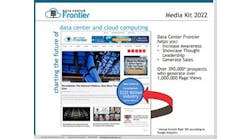Public Sector & Government Data Center Trends: IT Modernization Initiatives
Isaac Negusse, Director, Federal Data Center Practice at Iron Mountain, discusses IT modernization initiatives in the public sector and government data center trends.
Isaac Negusse, Director, Federal Data Center Practice at Iron Mountain
As innovation and demand for information technology continues to increase, IT departments of all sizes are facing incredible pressure to finish building a new way of delivering services – one that scales quickly, integrates multiple clouds and data centers, and performs to end-user and auditor expectations.
In the midst of creating this brave new world, the same teams are faced with increased mass-market adoption of the latest buzzword technologies – artificial intelligence, machine learning, IoT, and numerous others. This adds new competitive, end-user, and executive expectations that compete for limited IT resources and slow down progress.
IT is a balancing act for any organization. However, the public sector can definitely make a case for most challenging, with layers of complexity that do not apply to the private sector added on top of general IT trends and end-user expectations. In this article we will explore the current snapshot of public-sector/government data center trends to gain perspective on the dedicated IT teams that fight to maximize satisfaction by keeping government systems and end-user experience on par – or even ahead – of the private sector.
Focus of Current Administration – Artificial Intelligence, Improved Digital Experience, STEM
As with a new CEO in a private-sector organization, a change in administration may bring new vision and strategic focus areas for the federal agencies supporting the U.S. government and the American population. This can make the life of an IT contributor difficult as they are in essence given 2 to 3 years to accomplish this new vision with transition in/out timing taken out of the time required to complete new initiatives.
New areas of focus as directed by the current administration include the 21stCentury Integrated Digital Experience Act (IDEA) and the American AI Initiative. The former, lays out specific minimum standards for government websites aimed at improving security, end-user experience, and accessibility by any American citizen – including special emphasis on accessibility for those with disabilities. Additionally, IDEA calls for more digital services to augment/replace in-person interaction for increased efficiency and convenience. This includes mobile optimization of government digital services.
New areas of focus as directed by the current administration include the 21stCentury Integrated Digital Experience Act (IDEA) and the American AI Initiative.
Federal websites have one year to meet the minimum requirements, and teams will submit annual progress reports on addressing all IDEA expectations. See the official bill here.
The American AI Initiative shows how government can invest in more than just transitioning of old systems. A still-new concept, AI has almost infinite use cases from national security to predictive analytics to improving overall quality of life. Check out an article on the AI initiative here.
One callout within the topic of the AI initiative that is necessary to sustain U.S. technology leadership is a heightened focus on Science, Technology, Engineering and Mathematics (STEM) education/programs. With IT unemployment at historic lows, finding the necessary talent to launch and maintain new initiatives is a challenge. The public sector must either invest in retraining (costly and time consuming) or recruit existing talent from private sector (even more costly). With a focus on STEM, the goal is to deliver more qualified U.S. technologists, well-versed in cloud, DevOps, security, and AI/IoT development.
The Pentagon has led the way on AI to date, the Defense Advanced Research Projects Agency (DARPA) investing $2 billion in AI last September. However, for non-defense agencies, the execution of the AI initiative will most likely require transitioning of funding from in-flight programs to execute, a challenge that will require collaboration and job re-training.
This illustrates another unique challenge for public-sector organizations – funding.
2019/2020 Federal Budgets Projected at 5% Growth Year-over-Year, Hitting $93/$94B in 2020
For those public-sector organizations that are funded by the American taxpayer, there is heightened awareness of how money is used. Financial efficiency is critical, as overspending can lead to heavy scrutiny and to the appearance of misused public trust.
Modular data centers inside a portion of the Iron Mountain data center in Phoenix. (Photo: IO/Iron Mountain)
To ensure financial efficiency and integrity, the government has long-implemented a labor-intensive sourcing processes, unique to the federal sector. Agencies put initiatives out for bid to ensure there is full transparency as to what vendors are selected and why, even including specific financial requirements such as stipulations that the agency receive services at the lowest possible, or most favored, rates. Procurement can take a long time to complete, slowing down execution of programs.
The good news is, even though procurement may take additional time, overall Federal IT budget growth is projected to outpace global IT spending with a year-over-year spending increase of 5% in 2020 compared to Gartner’s projection of 3.2% for overall global IT spending. The expected budget may exceed $93 billion. The additional funding is expected to be allocated to the initiatives cited above and continued utilization and enhancement of cloud environments.
Continued Focus: Increased Utilization and Enhancement of Cloud Computing to Enable Digital Transformation, Federal IT Systems Scalability, Agility, Financial Efficiency
“The public sector is facing the biggest digital transformation in history,” says Shannon Hulbert, CEO of Opus Interactive, a woman-owned cloud, colocation, and IT services company based in Portland, Ore., that provides services from Iron Mountain’s Virginia data center. “In many cases, they’re using legacy applications that were used to performing in silos. Now they’re taking many organizations and trying to find the most optimized solutions for all. Applications must be able to talk together. Across the board in commercial and government sectors, people are collaborating and building things that are more workload intensive than ever. Security is a huge challenge, and for many agencies, data must remain within our borders. The whole vendor supply chain must be considered.”
In some cases, IT programs are continued across different administrations due to how critical they are to the short and long-term health of Federal IT. In today’s world, this is cloud computing.
In 2011, the Office of Management and Budget (OMB) released the “Cloud First” Initiative, a mandate that forced IT organizations to evaluate cloud computing and outsourcing before implementing traditional in-house solutions. Cloud offered the potential of increased agility and financial efficiency with pay-as-you-go, elastic resources, but with the challenge of new skills required to implement the new delivery model.
This was combined with the Data Center Optimization Initiative (DCOI), which requires agencies to optimize and consolidate data centers to deliver better services to the public while increasing ROI to taxpayers. DCOI recognizes the important role of the cloud and has stricter rules and goals to reduce the government’s climatic data center inventory and the expenditure to maintain it.
In 2018, Cloud First has been updated to the Federal Cloud Computing Strategy, commonly known as “Cloud Smart.” The Cloud Smart Strategy offers additional guidance on necessary security, procurement, and workforce skills to foster cloud adoption and implementation.
According to Hulbert, “Cloud Smart is taking things a step further. Across the board, government agrees on hybrid IT/hybrid cloud as the way forward, which is where commercial is right now. At Opus Interactive, our job is to help public-sector organizations make meaningful progress on this vision – from initial strategy to road mapping and migration to implementation and maintenance. Demand is steady, and we are pleased to report numerous agencies making steady progress towards their lofty goals and Federal mandates.”
Two examples of significant investments in cloud-based initiatives include the $10 billion Joint Enterprise Defense Infrastructure (JEDI) and the Defense Enterprise Office contracts.
Even Though Energy Efficiency Is Not Listed as a Core Focus of This Administration, Public-Sector IT Departments Continue to Make Progress on ‘Good for Business-the American People-and the Environment’ Initiatives
Furthering the DCOI conversation, Federal agencies continue to work towards closing/consolidating data centers. The Office of Management and Budget’s last report showed that some 4,477 non-tiered data centers and more than 470 tiered data centers have been closed, with a savings of more than $2 billion since 2016. This savings can be re-invested in new initiatives such as AI and IDEA, amongst others.
Increased energy efficiency has been a bonus result of the decreased data center footprint as a large percentage of closed/consolidated data centers were outdated and underutilized, leading to significant amounts of energy waste.
With colocation, public-sector organizations reduce costs when compared to DIY, increase energy efficiency, and reduce system complexity.
Although Executive Order 13693 has been discontinued, specific agency programs such as the Better Buildings Challenge from the U.S. Department of Energy continue to drive positive change across public and private sector organizations.
More than 900 public- and private-sector organizations have taken part and shared their innovative approaches to energy and water efficiency. To date, some 2,500 best practice examples are available in the Better Buildings Solution Center.
The 2019 Better Buildings Progress Report lists a savings of 1.38 quadrillion British thermal units, which is about $8.4 billion in energy and costs. The report highlights accomplishments in the public sector to improve energy productivity.
Within the data center niche, 23 partners with more than 75 MW of electric load have committed to reducing the infrastructure energy intensity of one or more data centers by 25% over a period of five years.
Iron Mountain committed to reducing the non-IT energy intensity of eight data centers by 20% over a 10-year period by utilizing green data center features such as geothermal cooling and infrastructure innovations including air and water-side economization. In 2019, we were honored to be named an Energy Savings Goal Achiever for reducing infrastructure energy intensity by 25%.
Where Does Colocation Fit in with the Changing Public-Sector IT Landscape?
As government data centers continue to change in size, location, and capabilities, colocation remains an excellent option for non-cloud and hybrid public-sector infrastructure and applications – assuming the colocation operator maintains the necessary compliance (FISMA High / NIST 800-53, Tier III, etc.).
With colocation, public-sector organizations reduce costs when compared to DIY, increase energy efficiency, and reduce system complexity. Most top-tier colocation providers offer multiple ways to connect to cloud providers like, Amazon Web Services, Microsoft Azure, Google Cloud Platform, Oracle, and IBM Softlayer from either within their facility, or from within a very short (low latency) hop away. Options include direct connection cloud on-ramps, software-defined network (SDN) exchanges, peering exchanges, colocation provider fiber to regional MMR’s, and private carrier circuits.
“I have a positive outlook for where things are headed in the public sector,” says Hulbert. “It’s good to see the government’s proactive approach on renewables and emphasis on sustainability. They seem to be cognizant of energy usage and optimization and how sustainability and energy usage are impacting those areas.”
In the event the public-sector leverages non-cloud infrastructure to deliver new AI/machine learning, IoT, and other big data applications, colocation facilities are an excellent choice as these higher density environments can be difficult to cool in legacy, in-house, data centers. Colocation facilities, in most cases, have the flexibility to address high-density requirements as a core competency – meaning faster speed to market, reduced costs, and increased reliability.
Finally, in a human-resource-constrained space, IT teams can leverage the data center operations teams of the colocation provider to augment their capabilities without blowing the budget. Data center services are available on-demand, 24-hours-a-day, and are increasingly focused on helping customers migrate as well as day-to-day operations.
Concluding Remarks
In conclusion, our teams would like to thank all of the public sector and federal IT professionals who work through so many challenges to ensure the public is protected, enabled, and connected. Despite funding challenges, procurement delays, policy changes, and the continuing development of newer and newer technologies, your teams remain focused on their agency missions in one of the more challenging IT environments, with one of the most challenging customers – all of us.
Isaac Negusse is Director of Federal Data Center Practice at Iron Mountain Data Centers.





